RBSE Class 10 Science Important Questions Chapter 11 Human Eye and Colourful World
Rajasthan Board RBSE Class 10 Science Important Questions Chapter 11 Human Eye and Colourful World Important Questions and Answers.
Rajasthan Board RBSE Solutions for Class 10 Science in Hindi Medium & English Medium are part of RBSE Solutions for Class 10. Students can also read RBSE Class 10 Science Important Questions for exam preparation. Students can also go through RBSE Class 10 Science Notes to understand and remember the concepts easily. Browsing through class 10 science chapter 12 question answer in hindi that includes all questions presented in the textbook.
RBSE Class 10 Science Chapter 11 Important Questions Human Eye and Colourful World
Objective Type Questions
Question 1.
Which colour light is used in the signal of ‘Danger’?
(a) Violet
(b) Blue
(c) Red
(d) Green.
Answer:
(c) Red

Question 2.
Human eye is capable of forming the correct image of the object placed at different positions. The reason is -
(a) Cataract
(b) Power of accommodation
(c) Near sightedness
(d) None of the above.
Answer:
(b) Power of accommodation
Question 3.
On retina, the image of an object formed is -
(a) Erect and real
(b) Erect and virtual
(c) Inverted and virtual
(d) Inverted and real
Answer:
(d) Inverted and real
On retina, the image of an object formed is -
(a) Erect and real
(b) Erect and virtual
(c) Inverted and virtual
(d) Inverted and real
Answer:
(d) Inverted and real
Question 4.
The change in focal length of an eye lens for the near and distant objects to form a clear image is due to -
(a) Retina
(b) Iris
(c) Pupil
(d) Ciliary muscles.
Answer:
(d) Ciliary muscles.
The change in focal length of an eye lens for the near and distant objects to form a clear image is due to -
(a) Retina
(b) Iris
(c) Pupil
(d) Ciliary muscles.
Answer:
(d) Ciliary muscles.

Question 5.
Following is used in a simple micro - scope -
(a) Convex lens of large focal length
(b) Convex lens of less focal length
(c) Concave lens of large focal length
(d) Concave lens of less focal length.
Answer:
(b) Convex lens of less focal length
Following is used in a simple micro - scope -
(a) Convex lens of large focal length
(b) Convex lens of less focal length
(c) Concave lens of large focal length
(d) Concave lens of less focal length.
Answer:
(b) Convex lens of less focal length
Question 6.
Blue colour of the sky is due to -
(a) Refraction of light
(b) Reflection of light
(c) Dispersion of light
(d) Scattering of light.
Answer:
(c) Dispersion of light
Blue colour of the sky is due to -
(a) Refraction of light
(b) Reflection of light
(c) Dispersion of light
(d) Scattering of light.
Answer:
(c) Dispersion of light
Question 7.
When light passes through a prism then maximum deviation is observed in -
(a) Yellow colour
(b) Red colour
(c) Violet colour
(d) Orange colour.
Answer:
(c) Violet colour
When light passes through a prism then maximum deviation is observed in -
(a) Yellow colour
(b) Red colour
(c) Violet colour
(d) Orange colour.
Answer:
(c) Violet colour
Question 8.
Formation or rainbow is due to -
(a) Only dispersion of light
(b) Only refraction of light
(c) Reflection and dispersion of light through water drops
(d) Reflection, refraction and dispersion of light in water droplets.
Answer:
(d) Reflection, refraction and dispersion of light in water droplets.

Very Short Answer Type Questions
Question 1.
Name the part of human eye which controls the amount of light entering the eye?
Answer:
Pupil.
Question 2.
What controls the size of the pupil?
Answer:
A dark muscular diaphragm controls the size of the pupil.
Question 3.
Name the lens used in eye after the surgery of cataract.
Answer:
Intra Ocular Lens [IOL].
Question 4.
What is Cataract ?
Answer:
Soirietimes, the crystalline lens of people at old age becomes milky and cloudy. This condition is called cataract.
Question 5.
Which type of spectacle is used to rectify the defect of presbyopia?
Answer:
Spectacle with bifocal lens.

Question 6.
Write the unit of power of lens.
Answer:
The unit of power of lens is dioptre.
Power of lens P =\( \frac{1}{f}\) Dioptre.
Where f is the focal length of lens measured in metre.
Write the unit of power of lens.
Answer:
The unit of power of lens is dioptre.
Power of lens P =\( \frac{1}{f}\) Dioptre.
Where f is the focal length of lens measured in metre.
Question 7.
What do you mean by Cornea?
Answer:
It is the front part of the human eye to focus the light made up of transparent membrane.
Question 8.
What is Iris?
Answer:
It is the coloured diaphragm of the eye which expands and contracts to regulate the size of the central opening called pupil.
What is Iris?
Answer:
It is the coloured diaphragm of the eye which expands and contracts to regulate the size of the central opening called pupil.
Question 9.
What is Accommodation ?
Answer:
The process in which lens changes its focal length to focus on objects at different distances is called accommodation.
Question 10.
What do you mean by near point?
Answer:
The minimum distance at which objects can be seen most distinctly without strain is called the near point of the eye.
Question 11.
What is least distance of human eye?
Answer:
For a normal eye the near point is located about 25 cm. from the eye. This distance is called least distance for normal vision.
Question 12.
What do you mean by range of vision? ,
Answer:
The distance between the near point and the far point of an eye is called range of vision. It is 25 cm. to infinity for a normal eye.

Question 13.
The ciliary muscles of our eye are in relaxed and contracted condition. In which condition the focal length is maximum of the above two conditions?
Answer:
The focal length of our eye lens is maximum when the ciliary muscles are in relaxed condition.
The ciliary muscles of our eye are in relaxed and contracted condition. In which condition the focal length is maximum of the above two conditions?
Answer:
The focal length of our eye lens is maximum when the ciliary muscles are in relaxed condition.
Question 14.
The vision of any object as small or big by the eye depends upon what?
Answer:
It depends upon the angle formed by the object on the eye.
Question 15.
Why is the signal of danger light red in colour? .
Answer:
The red light is least scattered by fog or smoke. So it is visible in the same colour from quite a large distance even through fog or smoke.
Question 16.
Why does the defect of hyper - metropia occur?
Answer:
- Due to the extraordinary increment in focal length of eye lens hypermetropia occurs.
- Decrease in the length of eyeball.

Question 17.
How can the defect of hypermetropia be rectified?
Answer:
The hypermetropic eye can be corrected by placing a convex lens of suitable focal length before the eye.
How can the defect of hypermetropia be rectified?
Answer:
The hypermetropic eye can be corrected by placing a convex lens of suitable focal length before the eye.
Question 18.
What are the reasons for near- sightedness defect ?
Answer:
- This defect may arise due to excessive curvature of the eye lens.
- It may also arise due to the elongation of the eyeball.
Question 19.
What is the reason for Presbyopia?
Answer:
This arises due to the gradual weakening of the ciliary muscles and diminishing flexibility of the eye lens.
Quesstion 20.
At present, how the refractive defects are corrected ?
Answer:
These days, it is possible to correct the refractive defects with contact lenses or through surgical interventions.
Question 21.
One pair of eyes can gives vision upto how many corneal blind people ?
Answer:
One pair of eyes gives vision upto four corneal blind people.

Question 22.
What do you mean by angle of deviation?
Answer:
The angle of deviation of a light ray is the angle between the refracted ray and the emergent ray.
What do you mean by angle of deviation?
Answer:
The angle of deviation of a light ray is the angle between the refracted ray and the emergent ray.
Question 23.
Name the colours for which the angle of deviation of a light ray is minimum and maximum.
Answer:
The angle of deviation for red colour is minimum whereas it is maximum for violet colour.
Question 24.
What is spectrum?
Answer:
The band of seven colours obtained after the dispersion of white light is called spectrum.
Question 25.
What do you mean by dispersion of light?
Answer:
The splitting of light into its component colours is called dispersion.
Question 26.
Which scientist had found out for the first time about the splitting of light into seven colours?
Answer:
Sir Issac Newton had found out about the splitting of light into seven colours.
Question 27.
Name the process which is involved in the formation of rainbow in the sky.
Answer:
Dispersion of light through the water droplets present in the atmosphere forms rainbow in the sky.
Question 28.
What are scatterers?
Answer:
Atoms or particles, which scatter the rays of light are called scatterers.
Question 29.
Why is the scattering of red colour light is less than the scattering of blue or violet colour?
Answer:
Because the wavelength of red colour is more than the wavelengths of blue or violet colour.

Question 30.
Why do the clouds appear white in colour?
Answer:
Because all the different colours are scattered in the sky only so clouds appear white in colour. •
Why do the clouds appear white in colour?
Answer:
Because all the different colours are scattered in the sky only so clouds appear white in colour. •
Question 31.
Which colour is scattered more in the earth’s atmosphere red or blue?
Answer:
Blue colour is scattered more in the sky.
Question 32.
What does the acronym ‘VIBGYOR’ mean ?
Answer:
The acronym ‘VIBGYOR’ refers to the short forms of the sequence of the colours. This is formed from the colours - Violet, Indigo, Blue, Green, Yellow, Orange and Red.
Question 33.
Give an example of natural spectrum.
Answer:
A rainbow is a natural spectrum appearing in the sky after a rain shower.
Question 34.
In which direction, rainbow is always formed ? .
Answer:
A rainbow is always formed in a direction opposite to that of the Sun.
Question 35.
What is the time difference between the actual sunset and delayed sunset ?
Answer:
The time difference between the actual sunset and delayed sunset is 2 minutes.

Short Answer Type Questions
Question 1.
Which type of light beam should the driver use at night and why ? Explain.
Answer:
The driver should use low beam of light at night so that the driver of the vehicle coming from front should not have a strong light beam. Due to the strong light beam, the driver of the vehicle coming from front could not open his eyes due to which there is a possibility of accident.
Question 2.
Why do we have two eyes for vision and not just one? Explain this on the basis of -
(a) Area of vision,
(b) On dimensional basis.
Answer:
Two eyes are better than one eye because -
(a) Two eyes gives a wider field of view. A human being has a horizontal field of view of about 150° with one eye and of about 180° with two eyes.
(b) With two eyes we get to know the length, breadth and depth of the object but with one eye we can only know the length and breadth of an object.
Question 3.
Draw a ray diagram of refraction of light from a prism and explain the phenomenon of white light dispersion.
Answer:
When a ray of white light is refracted from a prism, each colour is refracted under different effect. For this reason, when a ray of white light passes through a prism, different colours of light bend through different angles with respect to the incident ray. This is why white light is dispersed into its seven colour.
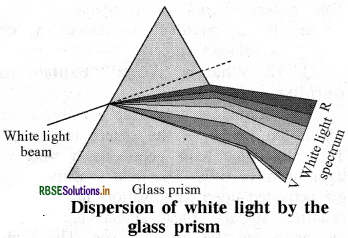
Question 4.
What happens when any damage or malfunction of any part of the visual system occur ? Explain.
Answer:
Damage to or malfunction of any part of the visual system can lead to significant loss of visual functioning. For example, if any of the structures involved in the transmission of light, like the cornea, pupil eye lens, aqueous humour and vitreous humour or those responsible for conversion of light to electrical impulse, like the retina or even the optic nerve that transmits these impulses to the brain, is damaged, it will result in visual impairment.
Question 5.
Find the power of lens having 0.5 m focal length.
Answer:
Power of lens P = \(\frac{1}{f}\) D
where f = 0.5 m
∴ P = \(\frac{1}{0.5}=\frac{10}{5} \)= 2 D
What happens when any damage or malfunction of any part of the visual system occur ? Explain.
Answer:
Damage to or malfunction of any part of the visual system can lead to significant loss of visual functioning. For example, if any of the structures involved in the transmission of light, like the cornea, pupil eye lens, aqueous humour and vitreous humour or those responsible for conversion of light to electrical impulse, like the retina or even the optic nerve that transmits these impulses to the brain, is damaged, it will result in visual impairment.
Question 5.
Find the power of lens having 0.5 m focal length.
Answer:
Power of lens P = \(\frac{1}{f}\) D
where f = 0.5 m
∴ P = \(\frac{1}{0.5}=\frac{10}{5} \)= 2 D

Question 6.
A 14 years old student is unable to see the questions written on a board kept at 5 m distance from him -
(a) Give the name of eye defect he is suffering from.
(b) With the help of a labelled diagram show how it can be rectified.
Answer:
(a) The name of the disease with which the student is suffering from is myopia (near sightedness).
(b) It can be rectified by using a concave lens (diverging lens) in the spectacles as shown in the diagram below -

A 14 years old student is unable to see the questions written on a board kept at 5 m distance from him -
(a) Give the name of eye defect he is suffering from.
(b) With the help of a labelled diagram show how it can be rectified.
Answer:
(a) The name of the disease with which the student is suffering from is myopia (near sightedness).
(b) It can be rectified by using a concave lens (diverging lens) in the spectacles as shown in the diagram below -

Question 7.
What are eye lens ? How the change in its shape affect the ability ? Explain.
Answer:
The eye lens is composed of a fibrous, jelly-like material. It forms an inverted and real image of the object on the retina. Its curvature can be modified to some extent by the ciliary muscles. The change in the curvature of the eye lens can thus change its focal length. When the muscles are relaxed, the lens becomes then. Thus, its focal length increases. This enables us to see distant objects clearly. When you are looking at objects closer to the eye, the ciliary muscles contract. This increases the curvature of the eye lens. The eye lens then becomes thicker. Consequently, the focal length of the >eye lens decreases. This enables us to see nearby objects clearly.
Question 8.
Why does the sun’s disc appear flat at the time of sunset and sunrise?
Answer:
The apparent flattening of the sun’s disc at sunrise and sunset is also due to atmospheric refraction. At the time of sunrise and sunset, sun is near the horizon so the light coming from the upper and lower edge bend unequally while travelling in atmosphere. Hence due to atmospheric refraction sun appears oval.
Question 9.
(a) What is Tyndall effect?
(b) Why the colour of the clear sky is blue?
Answer:
(a) The phenomenon of scattering of light by the colloidal particles give rise to Tyndall effect. It is the phenomenon of glowing of path of light due to scattering of light by colloidal particles.
Various observation of Tyndall effects are :
- Tyndall effect is seen when a. fine beam of sunlight enters a smoke-filled room through a small hole. Thus, scattering of light makes the particles visible.
- When sunlight passes through canopy of dense forest, tiny droplet and other small dust particles scatter the light due to which its path become visible.
(b) The molecules of air and other fine particles in the atmosphere have size smaller than the wavelength of visible light. These are more effective in scattering light of shorter wavelengths at the blue end than light of longer wavelengths at the red end. The red light has a wavelength of about 1.8 times greater than blue light. Thus, when sunlight passes through the atmosphere, the fine particles in air scatter the blue colour (shorter wavelengths) more strongly than red. The scattered blue light enters our eyes. Therefore the colour of the clear sky is blue.

Question 10.
A light ray passes through a prism and a spectrum is obtained on a screen -
(a) Draw a diagram that shows the spectrum of white light.
(b) Name the seven colours of the spectrum in order.
(c) Which colour of spectrum shows least and which colour of spectrum shows maximum deviation?
Answer:
(a)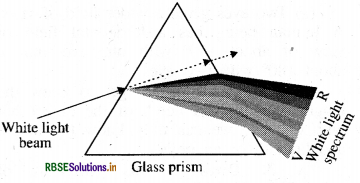
(b) The order of seven colours of spectrum (From top to bottom) is red, orange, yellow, green, blue, indigo, violet.
(c) Maximum deviation is shown by violet colour and minimum deviation is shown by red colour.
A light ray passes through a prism and a spectrum is obtained on a screen -
(a) Draw a diagram that shows the spectrum of white light.
(b) Name the seven colours of the spectrum in order.
(c) Which colour of spectrum shows least and which colour of spectrum shows maximum deviation?
Answer:
(a)

(b) The order of seven colours of spectrum (From top to bottom) is red, orange, yellow, green, blue, indigo, violet.
(c) Maximum deviation is shown by violet colour and minimum deviation is shown by red colour.
Question 11.
What do you mean by cataract? Is it possible to cure it ?
Answer:
Sometimes, the crystalline lens of people at old age becomes milky and cloudy. This condition is called cataract. This causes partial or complete loss of vision. It is possible to restore vision through a cataract surgery.
Question 12.
What is ‘retina’? Explain its working.
Answer:
Retina is a delicate membrane on which the image of the object is formed. This membrane have enormous number of light sensitive cells. The light sensitive cells get activated upon illumination and generate electrical signals. These signals are sent to the brain via the optic nerves. The brain interprets these signals, and finally, processes the information so that we perceive objects as they are.
Question 13.
Draw a ray diagram for a myopic eye and a hypermetropic eye. Write the value of least distance of distinct vision.
Answer:

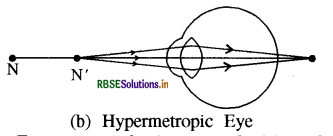
For a person having normal vision, the value of least distance of distinct vision is 25 cm.

Question 14.
What are bifocal lens ? What are its uses ?
Answer:
A common type of bi-focal lenses consists of both concave and convex lens. The upper portion consists of a concave lens. It facilitates distant vision. The lower part is a convex lens. It facilitates near vision. These lens are often required by person who suffer from both myopia and hypermetropia.
Question 15.
What do you mean by intra ocular lens? Explain.
Answer:
Sometimes, the crystalline lens of people at old age becomes milky and cloudy. This condition is called cataract. This causes partial or complete loss of vision. It is possible to restore vision through a cataract surgery. It can be rectified by using an intra ocular lens. In this process, the cataract is removed and infra ocular lens is placed in front of the thin membrane.
Question 16.
When we enter in a dark room from a very bright room, we are unable to see the things for some time. Explain it, why?
Answer:
When the light is very intense, the iris contracts and the pupil becomes small so that very less light can enter the eye. When we enter from a bright light room to a dim light room, then in starting we are unable to' see the things kept in the room, because the pupil of eye takes some time to expand. In dim light the iris expands and make the size of pupil big, so that more light can enter the eye. In dim light due to the relaxation of iris, the pupil opens completely and we are able to see the objects.

Question 17.
What are ‘eye - bank’ ?
Answer:
An eye bank collects, evaluates and distributes the donated eyes. All eyes donated are evaluated using strict medical standards. Those donated eyes found unsuitable for transplantation are used for valuable research and medical education. The identities of both the donar and the recipient remain confidential.
Question 18.
How can we find the focal length and power of a lens used to rectify long sightedness?
Answer:
Let the object be seen by the hypermetropic person kept at O whose distance from eye is 25 cm. (least distance of distinct vision). The lens used in the spectacle convex lens (converging lens) forms its image at O'.
Hence u = -25 cm and v = -d
From lens formula\( \frac{1}{f}=\frac{1}{v}-\frac{1}{u}\)
\(\frac{1}{f}=\frac{1}{-d}-\left(\frac{1}{-25}\right)=\frac{1}{-d}+\frac{1}{25}\)
We can find out the focal length of the convex lens used in spectacle by the above formula.
Power of lens P =\( \frac{100}{f(\mathrm{~cm})}\)
Question 19.
When a white light passes a prism then why it is dispersed into its seven colour components ? .
Answer:
White light is dispersed into its seven colour components by a prism. Different colours of light bend through different angles with respect to the incident ray as they pass through a prism. The red light bends the least while the violet the most. Thus the rays of each colour emerge along different paths and thus become distinct.

Question 20.
How can we find out the focal length and power of concave lens which is used in spectacles for correction of myopia ? Explain.
Answer:
To rectify myopia, the concave lens diverge the rays coming from infinity and entering to the eye. Let this lensimagine the ray of light coming from ('O'). Let this far point be at a distance ('d'). Image is situated at D and formed at a distance ('d’). '
Hence u= ∞ and v = - d.
From lens formula
\(\begin{aligned} &\frac{1}{f}=-\frac{1}{u}+\frac{1}{v} \\ &\frac{1}{f}=-\frac{1}{\infty}+\frac{1}{(-d)} \\ &\frac{1}{f}=-\frac{1}{d} \end{aligned}\)
Hence we can find out the focal length of the concave lens used in the spectacles by using above formula.
Power of lens P =\(=\frac{100}{f(\text { in } \mathrm{cm})}\)
How can we find out the focal length and power of concave lens which is used in spectacles for correction of myopia ? Explain.
Answer:
To rectify myopia, the concave lens diverge the rays coming from infinity and entering to the eye. Let this lensimagine the ray of light coming from ('O'). Let this far point be at a distance ('d'). Image is situated at D and formed at a distance ('d’). '
Hence u= ∞ and v = - d.
From lens formula
\(\begin{aligned} &\frac{1}{f}=-\frac{1}{u}+\frac{1}{v} \\ &\frac{1}{f}=-\frac{1}{\infty}+\frac{1}{(-d)} \\ &\frac{1}{f}=-\frac{1}{d} \end{aligned}\)
Hence we can find out the focal length of the concave lens used in the spectacles by using above formula.
Power of lens P =\(=\frac{100}{f(\text { in } \mathrm{cm})}\)
Question 21.
On what does the scattering of light depends upon?
Answer:
The colour of the scattered light depends on the size of the scattering particles. Very fine particles scatter mainly blue light while particles of larger size scatter light of longer wavelengths. If the size of the scattering particles is large enough, then, the scattered light may even appear white.
On what does the scattering of light depends upon?
Answer:
The colour of the scattered light depends on the size of the scattering particles. Very fine particles scatter mainly blue light while particles of larger size scatter light of longer wavelengths. If the size of the scattering particles is large enough, then, the scattered light may even appear white.
Question 22.
Draw a ray diagram to show reflected ray, refracted ray, emergent ray and angle of deviation.
Or
Draw a ray diagram to show refraction of light through a triangular glass prism.
Answer:
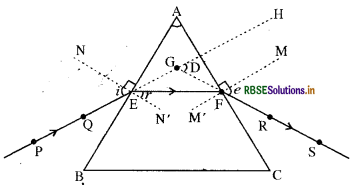
PE - Incident ray ∠i - Angle of incidence
EF - Refracted ray ∠r - Angle of refraction
FS - Emergent ray ∠e - Angle of emergence
∠A - Angle of the prism ∠D - Angle of deviation
Refraction of light through a triangular glass prism
Draw a ray diagram to show reflected ray, refracted ray, emergent ray and angle of deviation.
Or
Draw a ray diagram to show refraction of light through a triangular glass prism.
Answer:

PE - Incident ray ∠i - Angle of incidence
EF - Refracted ray ∠r - Angle of refraction
FS - Emergent ray ∠e - Angle of emergence
∠A - Angle of the prism ∠D - Angle of deviation
Refraction of light through a triangular glass prism
Question 23.
A ray of light while passing through a prism can show how many refraction and at every refraction what would be the direction?
Answer:
When a light ray passes through a prism, it refracts two times - first when it enters from air into glass and second when it enters into air from glass. Both times it bends towards the surface of prism.
A ray of light while passing through a prism can show how many refraction and at every refraction what would be the direction?
Answer:
When a light ray passes through a prism, it refracts two times - first when it enters from air into glass and second when it enters into air from glass. Both times it bends towards the surface of prism.
Question 24.
Why does a flicker appear over a fire or furnace? Explain.
Answer:
The apparent random wavering or flickering of objects seen through a turbulent stream of hot air rising above a fire. The air just above the fire becomes hotter than the air further up. The hotter air is lighter (less dense) than the cooler air above it, and has a refractive index slightly less than that of the cooler air. Since the physical conditions of the refracting medium (air) are not stationary, the apparent position of the object, as seen through the hot air, fluctuates.
Why does a flicker appear over a fire or furnace? Explain.
Answer:
The apparent random wavering or flickering of objects seen through a turbulent stream of hot air rising above a fire. The air just above the fire becomes hotter than the air further up. The hotter air is lighter (less dense) than the cooler air above it, and has a refractive index slightly less than that of the cooler air. Since the physical conditions of the refracting medium (air) are not stationary, the apparent position of the object, as seen through the hot air, fluctuates.

Question 25.
What do you mean by dispersion of colours?
Answer:
The sunlight when passes through a prism forms a band of seven colours on a screen. This band of seven colours is called spectrum. The sequence of colours in the spectrum of sunlight is red, orange, yellow, green, blue, indigo and violet. The splitting of white light into different colours is called, dispersion of colours.
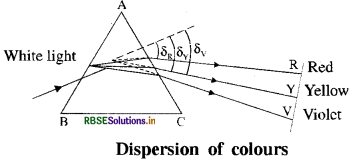
What do you mean by dispersion of colours?
Answer:
The sunlight when passes through a prism forms a band of seven colours on a screen. This band of seven colours is called spectrum. The sequence of colours in the spectrum of sunlight is red, orange, yellow, green, blue, indigo and violet. The splitting of white light into different colours is called, dispersion of colours.

Question 26.
How do you define the angle of deviation of a ray of light passing through a prism ? Explain.
Answer:
The peculiar shape of the prism makes the emergent ray bend at an angle to the direction of the incident ray. This angle is called the angle of deviation.
Features -
How do you define the angle of deviation of a ray of light passing through a prism ? Explain.
Answer:
The peculiar shape of the prism makes the emergent ray bend at an angle to the direction of the incident ray. This angle is called the angle of deviation.
Features -
- The angle of deviation of light of different colour also varies.
- The angle of deviation of red light is minimum and the angle of deviation of violet light is maximum.
Question 27.
A beam of white light splits into seven different colours after passing through a prism as shown in the figure. A student gives following conclusions on seeing the spectrum on screen -
Which two positions show colour -
(i) Colour of potassium permanganate solution.
(ii) Colour of danger signal.
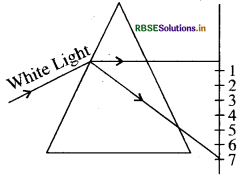
Answer:
A beam of white light splits into seven different colours after passing through a prism as shown in the figure. A student gives following conclusions on seeing the spectrum on screen -
Which two positions show colour -
(i) Colour of potassium permanganate solution.
(ii) Colour of danger signal.

Answer:
The sequence of colours from 1 to 7 is -
- Red
- Orange
- Yellow
- Green
- Blue
- Indigo
- Violet.
(i) At No. 6 indigo colour is there which is the colour of potassium permanganate solution.
(ii) At number 1 red colour is there which is the colour of danger signal.
(ii) At number 1 red colour is there which is the colour of danger signal.

Essay Type Questions
Question 1.
Draw a labelled diagram of human eye and explain its structure and working.
Answer:
The human eye is like a camera. Its lens system forms an image on a light- sensitive screen called the retina. Light enters the eye through a thin membrane called the cornea. It forms the transparent bulge on the front surface of the eyeball.
The eyeball is approximately spherical in shape with a diameter of about 2.3 cm. Most of the refraction for the light rays entering the eye occurs at the outer surface of the cornea. The crystalline lens merely provides the finer adjustment of focal length required to focus objects at different distance on the retina. We find a structure called iris behind the cornea. Iris is a dark muscular diaphragm that controls the size of the pupil. The pupil regulates and controls the amount of light entering the eye. The eye lens forms an inverted, real image of the object on the retina.
Draw a labelled diagram of human eye and explain its structure and working.
Answer:
The human eye is like a camera. Its lens system forms an image on a light- sensitive screen called the retina. Light enters the eye through a thin membrane called the cornea. It forms the transparent bulge on the front surface of the eyeball.
The eyeball is approximately spherical in shape with a diameter of about 2.3 cm. Most of the refraction for the light rays entering the eye occurs at the outer surface of the cornea. The crystalline lens merely provides the finer adjustment of focal length required to focus objects at different distance on the retina. We find a structure called iris behind the cornea. Iris is a dark muscular diaphragm that controls the size of the pupil. The pupil regulates and controls the amount of light entering the eye. The eye lens forms an inverted, real image of the object on the retina.
Working of Eye to view an object: The retina is a delicate membrane having enormous number of light-sensitive cells. The light-sensitive cells get activated upon illumination and generate electrical signals. These signals are sent to the brain via the optic nerves. The brain interprets these signals, and finally, processes the information so that we percieve objects as they are.
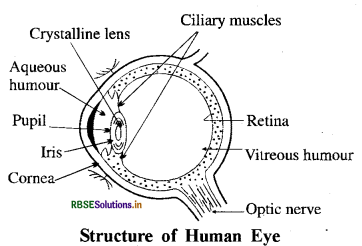

Question 2.
Explain the main defects of eye and their rectification.
Answer:
Defects of vision and their correction: If image of the object does not form at retina the eye has some defects of vision. Following are the common defects of vision -
1. Myopia (Short-Sightedness):
It is a defect of vision by which a person can see objects situated nearby and cannot see objects situated far away. For such a person, the far point of the eye is not at infinity and may even be as close to the eye as three or four metres. Rays starting from objects situated nearby meet on the retina after refraction through the eye lens. Eye is able to exert accommodation upto F only. So F is called the ‘far point’ of the eye. It means a man cannot see the objects clearly lying beyond ‘far point’ [Fig. (a)]. Rays coming from infinity meet at a point short of retina so that only a blurred vision impression is formed on the retina.
Cause:
There are two reasons for this defect:
(i) Increase in the length of eyeball.
(ii) Decrease of the focal length of the lens.
Remedy: It can be corrected by using a concave lens of appropriate power and focal length.
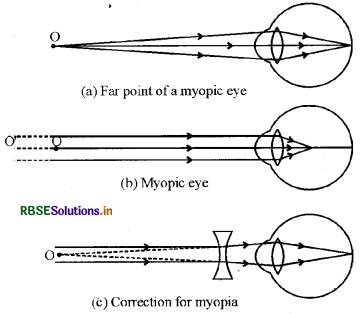
2. Long-Sightedness or Hypermetropia:
A farsighted (hypermetropic) person can usually see distant objects clearly, but cannot see objects situated nearby. In this case the image formed by eye lens is beyond retina.
Starting from infinity, the objects are visible due to the accommodation of eye up to the point N [Fig. (a)], which is called the near point for the eye. N is the least distance of distinct vision (= 25 cm). In figure (b), a hypermetropic eye is shown in which rays from the normal near point N are focussed at a point I beyond the retina of the eye. This is the cause why objects lying at near point are not clearly seen by the hypermetropic eye. In the same figure, we have also shown the actual position of N and its focussing at retina. This shows that near point of the defective eye has shifted from N to point N' It means objects that are very close to the eye than the point N' cannot be seen clearly by the defective eye.
Cause:
Following are the causes of this defect -
(i) Decrease in the length of eyeball.
(ii) Increase in the focal length of the eye lens.
Remedy:
The hypermetropic eye can be corrected by placing a convex lens of suitable focal length before the eye
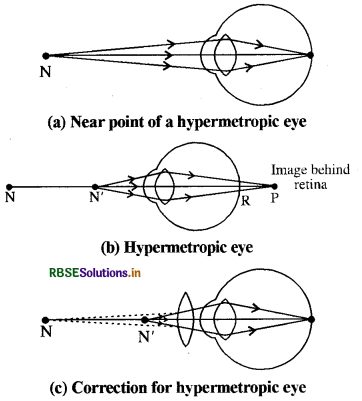
3. Presbyopia:
The power of acco-mmodation of the eye usually decreases with ageing. For most people, the near point gradually recedes away. They find it difficult to see nearby objects comfortably and distinctly without corrective eye - glasses. This defect is called Presbyopia. It arises due to the gradual weakening of the ciliary muscles and diminishing flexibility of the eye lens. Sometimes, a person may suffer from both myopia and hyper - metropia. Such people often require bifocal lenses. A common type of bi-focal lenses consists of both concave and convex lenses. The upper portion consists of a concave lens. It facilitates distant vision. The lower part is a convex lens. It facilitates near vision.
Explain the main defects of eye and their rectification.
Answer:
Defects of vision and their correction: If image of the object does not form at retina the eye has some defects of vision. Following are the common defects of vision -
1. Myopia (Short-Sightedness):
It is a defect of vision by which a person can see objects situated nearby and cannot see objects situated far away. For such a person, the far point of the eye is not at infinity and may even be as close to the eye as three or four metres. Rays starting from objects situated nearby meet on the retina after refraction through the eye lens. Eye is able to exert accommodation upto F only. So F is called the ‘far point’ of the eye. It means a man cannot see the objects clearly lying beyond ‘far point’ [Fig. (a)]. Rays coming from infinity meet at a point short of retina so that only a blurred vision impression is formed on the retina.
Cause:
There are two reasons for this defect:
(i) Increase in the length of eyeball.
(ii) Decrease of the focal length of the lens.
Remedy: It can be corrected by using a concave lens of appropriate power and focal length.

2. Long-Sightedness or Hypermetropia:
A farsighted (hypermetropic) person can usually see distant objects clearly, but cannot see objects situated nearby. In this case the image formed by eye lens is beyond retina.
Starting from infinity, the objects are visible due to the accommodation of eye up to the point N [Fig. (a)], which is called the near point for the eye. N is the least distance of distinct vision (= 25 cm). In figure (b), a hypermetropic eye is shown in which rays from the normal near point N are focussed at a point I beyond the retina of the eye. This is the cause why objects lying at near point are not clearly seen by the hypermetropic eye. In the same figure, we have also shown the actual position of N and its focussing at retina. This shows that near point of the defective eye has shifted from N to point N' It means objects that are very close to the eye than the point N' cannot be seen clearly by the defective eye.
Cause:
Following are the causes of this defect -
(i) Decrease in the length of eyeball.
(ii) Increase in the focal length of the eye lens.
Remedy:
The hypermetropic eye can be corrected by placing a convex lens of suitable focal length before the eye

3. Presbyopia:
The power of acco-mmodation of the eye usually decreases with ageing. For most people, the near point gradually recedes away. They find it difficult to see nearby objects comfortably and distinctly without corrective eye - glasses. This defect is called Presbyopia. It arises due to the gradual weakening of the ciliary muscles and diminishing flexibility of the eye lens. Sometimes, a person may suffer from both myopia and hyper - metropia. Such people often require bifocal lenses. A common type of bi-focal lenses consists of both concave and convex lenses. The upper portion consists of a concave lens. It facilitates distant vision. The lower part is a convex lens. It facilitates near vision.

Question 3.
Explaining the importance of eye donation, tell us what things should be kept in mind while making eye donation.
Answer:
Our eyes can live even after our death. By donating our eyes after we die, we can light the life of a blind person.
About 35 million people in the developing world are blind and most of them can be cured. About 4.5 million people with corneal blindness can be cured through corneal transplantation of donated eyes. Out of .these 4.5 million, 60% are children below the age of 12. Things to keep in mind when eyes have to be donated -
Explaining the importance of eye donation, tell us what things should be kept in mind while making eye donation.
Answer:
Our eyes can live even after our death. By donating our eyes after we die, we can light the life of a blind person.
About 35 million people in the developing world are blind and most of them can be cured. About 4.5 million people with corneal blindness can be cured through corneal transplantation of donated eyes. Out of .these 4.5 million, 60% are children below the age of 12. Things to keep in mind when eyes have to be donated -
- Eye donars can belong to any age group or sex. People who use spectacles, or those operated for cataract, can still donate eyes. People who are diabetic, have hypertension, asthma patients and those without communicable diseases can also donate eyes. ‘
- Eyes must be removed within 4-6 hours after death. Inform the nearest eye bank immediately.
- The eye bank team will remove the eyes at the home of the deceased or at a hospital.
- Eye removal takes only 10-15 minutes. It is a simple process and does not lead to any disfigurement.
- Persohs who were infected with or died because of AIDS, Hepatitis B or C, rabies, acute leukaemia, tetanus, cholera, meningitis or encephalitis cannot donate eyes.

Question 4.
What is atmospheric refraction? Explain some phenomenon related to atmospheric refraction.
Answer:
Atmospheric Refraction:
When the light radiation coming from sun or any' other stars enters in earth's atmosphere it undergoes multiple refraction due to passing through different layers of atmosphere. This is called atmospheric refraction.
Some phenomenon related to atmospheric refraction are as follows -
(1) Twinkling of Stars:
The light of star when enters into earth’s, atmosphere undergoes refraction continuously before it reaches the earth. As the atmospheric refraction occurs in a continuously changing refractive index, due to which the amount of light and apparent position of stars reaching to our eyes changes many times. Due to which stars appears to be twinkle.
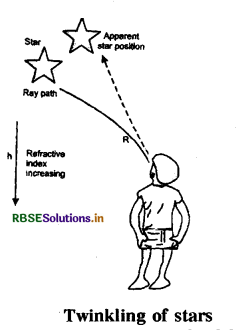
(2) Advanced sunrise and delayed sunset:
The sun is visible to us about 2 minutes before the actual sunrise, and about 2 minutes after the actual sunset. This phenomenon is also due to atmospheric refraction. When the sun is slightly below the horizon the light coining from sun bend continuously as it travel through rarer medium to denser medium so the sun appears to be raised above horizon. In same way due to atmospheric refraction sun is visible to us for two minutes after sunset. In the figure shown below A is the actual position of sun at the time of sunrise but it appears at position B.
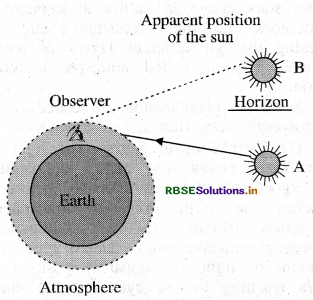
(3) Red Colour of sun at sunrise and sunset:
In the morning and evening when the sun is near the horizon, light has to travel a greater distance through the atmosphere. The violet and blue wavelengths are scattered by dust particles and air molecules at an angle of about 90°. The sunlight thus becomes devoid of shorter wavelengths and the longer wavelength of red colour reaches the observer. So the sun appears to us as red.
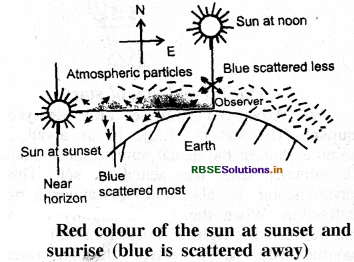
What is atmospheric refraction? Explain some phenomenon related to atmospheric refraction.
Answer:
Atmospheric Refraction:
When the light radiation coming from sun or any' other stars enters in earth's atmosphere it undergoes multiple refraction due to passing through different layers of atmosphere. This is called atmospheric refraction.
Some phenomenon related to atmospheric refraction are as follows -
(1) Twinkling of Stars:
The light of star when enters into earth’s, atmosphere undergoes refraction continuously before it reaches the earth. As the atmospheric refraction occurs in a continuously changing refractive index, due to which the amount of light and apparent position of stars reaching to our eyes changes many times. Due to which stars appears to be twinkle.

(2) Advanced sunrise and delayed sunset:
The sun is visible to us about 2 minutes before the actual sunrise, and about 2 minutes after the actual sunset. This phenomenon is also due to atmospheric refraction. When the sun is slightly below the horizon the light coining from sun bend continuously as it travel through rarer medium to denser medium so the sun appears to be raised above horizon. In same way due to atmospheric refraction sun is visible to us for two minutes after sunset. In the figure shown below A is the actual position of sun at the time of sunrise but it appears at position B.

(3) Red Colour of sun at sunrise and sunset:
In the morning and evening when the sun is near the horizon, light has to travel a greater distance through the atmosphere. The violet and blue wavelengths are scattered by dust particles and air molecules at an angle of about 90°. The sunlight thus becomes devoid of shorter wavelengths and the longer wavelength of red colour reaches the observer. So the sun appears to us as red.

Question 5.
(a) Define prism angle and angle of deviation for a prism. Write the sequence of colours in the spectrum formed by the passage of white light through a prism.
(b) Explain the process of formation of rainbow.
Answer:
(a) Anlge of Prism: Prism is the transparent medium bounded by two surfaces inclined at some angle. Angle of prism is the angle between two surfaces of the prism.
Angle of deviation: Angle of deviation is the angle formed between direction of incident ray and emergent ray of light known as angle of deviation.
The names of the colours obtained by passing ray of white light through a prism are as under - In short it is known as VIBGYOR.
Like
- Violet
- Indigo
- Blue
- Green
- Yellow
- Orange and
- Red.
(b) Process of formation of a rainbow -
A rainbow is a natural spectrum appearing in the sky after a rain shower. It is caused by dispersion of sunlight by tiny water droplets, present in the atmosphere. A rainbow is always formed in a direction opposite to that of the Sun. The water droplets act like small prisms. They refract and disperse the incident sunlight, then reflect it internally, and finally refract it again when it comes out of the raindrop. Due to the dispersion of light and internal reflection, different colours reach the observer’s eye.
We can also see a rainbow on a sunny day when we look at the sky through a waterfall or through a water fountain, with the Sun behind us.
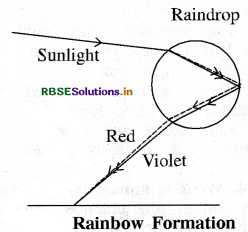
A rainbow is a natural spectrum appearing in the sky after a rain shower. It is caused by dispersion of sunlight by tiny water droplets, present in the atmosphere. A rainbow is always formed in a direction opposite to that of the Sun. The water droplets act like small prisms. They refract and disperse the incident sunlight, then reflect it internally, and finally refract it again when it comes out of the raindrop. Due to the dispersion of light and internal reflection, different colours reach the observer’s eye.
We can also see a rainbow on a sunny day when we look at the sky through a waterfall or through a water fountain, with the Sun behind us.


Question 6.
How we can show that the sunlight is made up of seven colours?
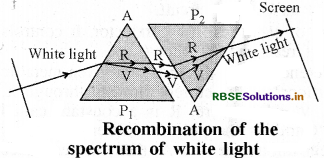
When white light of sun is allowed to pass through a prism then the spectrum of sunlight is obtained, in which the white light is dispersed into its seven colours. Now if a second identical prism is placed in an inverted position with respect to the first prism then it will allow all the colours of the spectrum to pass through second prism. Now it is seen that a beam of white light is emmerging from the other side of the second prism. This activity proves that the sunlight is made up of seven colours.

- RBSE Solutions for Class 10 Science Chapter 12 विद्युत
- RBSE Class 10 Science Notes in Hindi & English Medium Pdf Download
- RBSE Class 10 Science Important Questions in Hindi & English Medium
- RBSE Solutions for Class 10 Science in Hindi Medium & English Medium
- RBSE Class 10 Science Important Questions Chapter 16 प्राकृतिक संसाधनों का संपोषित प्रबंधन
- RBSE Class 10 Science Important Questions Chapter 13 विद्युत धारा का चुम्बकीय प्रभाव
- RBSE Class 10 Science Important Questions Chapter 10 प्रकाश - परावर्तन तथा अपवर्तन
- RBSE Class 10 Science Important Questions Chapter 11 मानव नेत्र एवं रंगबिरंगा संसार
- RBSE Class 10 Science Important Questions Chapter 12 विद्युत
- RBSE Class 10 Science Important Questions Chapter 14 उर्जा के स्रोत
- RBSE Class 10 Science Important Questions Chapter 15 हमारा पर्यावरण